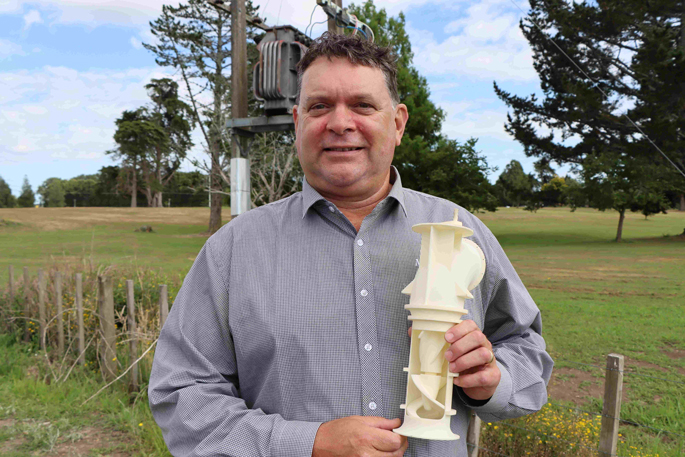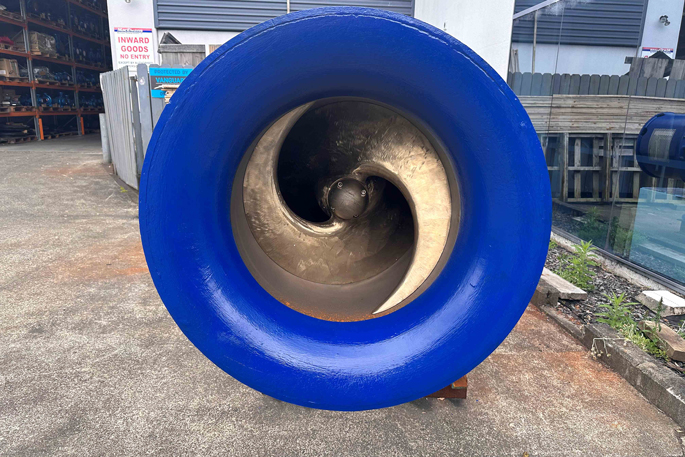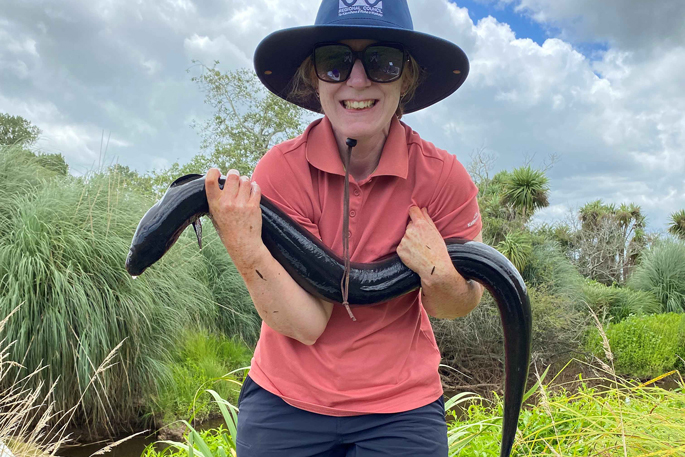New Zealand’s first home-grown fish-friendly flood pump, commissioned by Waikato Regional Council, has successfully passed a 1.2-metre-long shortfin eel.
The prototype pump, which has been developed to replace existing MacEwans PPF axial pumps and is being tested by the council, was installed at the council’s Huntly golf course pump station in December.
The new pump kicked into action at the end of January with the arrival of heavy rain (28 January), and seven tuna/eels passed through into a net attached to its outlet as part of the council’s monitoring programme to determine the pump’s success.
Pathways to the Sea programme manager Michelle White says the largest tuna was 1.2 metres in length and weighed 4.2 kilograms, while the other six ranged in size from 664 millimetres to 878 millimetres. The eels were released in the lower catchment and are now free to safely make their way out to sea to breed.
“This is an awesome first result,” says Michelle. “The big eel was a resident shortfin eel that had been living in the catchment for decades. This eel is a developing migrant and was in perfect condition after going through the pump.”
The council, which owns and operates over 120 pump stations, many of them with MacEwans pumps, first started its journey to ensure safe fish passage in 2015 with an investigation that showed there could be significant mortality of tuna over 600 millimetres in length as they travel through existing flood pumps during migration to the sea.
In response to this finding, the council set up its Pathways to the Sea research and development programme to improve downstream fish passage at pump stations.
The council approached MacEwans Pumping Systems to develop a fish-friendly pump and the New Zealand company jumped at the opportunity.
MacEwans Pumping Systems general manager Tom Bailey says the challenge to build a fish-friendly pump really opened his eyes to the life cycle of New Zealand short and long finned eels, which breed only once, at the end of their life, and at sea.
 MacEwans Pumping Systems general manager Tom Bailey with a model of the new pump.
MacEwans Pumping Systems general manager Tom Bailey with a model of the new pump.
“We’d been approached by councils to build fish-friendly pumps for a couple of years but to have Waikato Regional Council willing to be involved, and have funding for the project, that made the decision a much easier one,” says Tom.
“I was so pleased with that big eel coming through! This has been a five-year endeavour with many challenges along the way, like Covid-19 and labour shortages, so to have this result the first time the pump operated is such a relief.”
Tom says the fish-friendly prototype has been designed to retrofit pumps with 24-inch impellers that MacEwans installed widely across New Zealand between the 1960s and 1980s.
“If this pump proves to be a success over the entire migration season, we’ll also look at changing out larger 30-inch impellers to fish friendly.”
Features of the new pump that make it fish friendly include a slower rotational speed, having only two blades compared to four, and ensuring more space between the impeller (rotating blades) and stator (outer cavity).
The development of the pump, with design assistance by Callaghan Innovation, included the creation of a scale-sized pump and testing using 3-D printed rubber eels – scaled equivalents of 800-millimetre eels, 1.2-metre eels and 1.5-metre eels.
High-speed videography shows even the 1500-millimetre eels made it through in one piece.
 The new pump has only two blades, instead of four, and has a slower rotational speed.
The new pump has only two blades, instead of four, and has a slower rotational speed.
Waikato Regional Council Integrated Catchment Management Director Greg Ryan says the development of the pump is exciting and “innovation in action”.
“There has been a huge amount of research that has got us to this point and early indications are that this pump is working as we expected it to,” says Greg.
“Our flood control schemes were built many, many years ago to safeguard lives and properties and enable productive use of the land. They knew what they knew back then when they put in this infrastructure, and not what we know now. The impact of these old pumps on these taonga species is something we want addressed.”
The council installed the country’s first fish friendly pump at Orchard Road, Te Kauwhata, in 2017, and another at its Mangawhero pump station in 2021. Two fish-friendly pumps are due to be put in at the council’s Churchill East pump station, Hampton Downs, at the end of February.
“We’re replacing our pumps as they come to their end of life with fish friendly ones, but no one was building them in New Zealand, so we’ve been having to look overseas for them,” says Greg.
“With a MacEwans fish-friendly pump, we’ll be able to retrofit our pump stations at a much lower cost as we won’t have to ship in pumps from overseas or completely redesign the infrastructure to accommodate them.”
The council is monitoring the fish friendliness of the pump until May, when the tuna migration season ends.
Waikato Regional Council put forward $280,000 towards the research and development of the MacEwans fish-friendly pump, which includes $120,000 from Waikato-Tainui. Funding partners in the council’s Pathways to the Sea research and development programme are Waikato River Authority, MPI Sustainable Farming Fund, NZ Lottery Grants Board, Hawke’s Bay Regional Council, Greater Wellington Regional Council, Bay of Plenty Regional Council, Nelson City Council, Marlborough District Council, Southland Regional Council, Waikato Catchment Ecological Enhancement Trust, Waikato-Tainui College for Research and Development, MacEwans Pumping Systems, Callaghan Innovation and the Department of Conservation.



1 comment
Eel pump
Posted on 04-02-2024 13:17 | By CliftonGuy
Looks a lot like an Archimedes Spiral to me.
Leave a Comment
You must be logged in to make a comment.